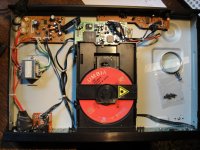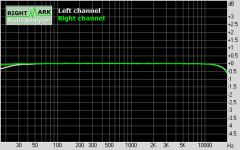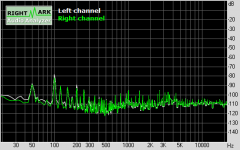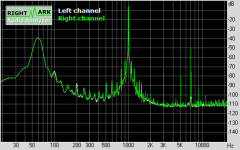I'm looking for a remote for a Cambridge Audio CD34
I thought it would be as for Philips (RC5) but it isn't, nor Sony nor Sharp. Tried a universal but got impossibly mixed-up functions on the only setting that got a response.
Any ideas?
Since the only information anywhere about this player is false, here are a few facts. Tiny main board is all SMD and dominated by huge video chip. I guess CD video didn't really happen much, and there was a lot of surplus boards to be found in skips.
Mech: VAM1202/12
DAC: SAA7327 CD video processor with bitstream DAC
CL8830 video/audio processor with MP2 decoder
headphone amp: TDA1308
can't find audio stage...need microscope maybe.
Sound is stark.
Facia plastic is delicious
All other plastic is Sino-functionalist, like my Maplin toaster
I thought it would be as for Philips (RC5) but it isn't, nor Sony nor Sharp. Tried a universal but got impossibly mixed-up functions on the only setting that got a response.
Any ideas?
Since the only information anywhere about this player is false, here are a few facts. Tiny main board is all SMD and dominated by huge video chip. I guess CD video didn't really happen much, and there was a lot of surplus boards to be found in skips.
Mech: VAM1202/12
DAC: SAA7327 CD video processor with bitstream DAC
CL8830 video/audio processor with MP2 decoder
headphone amp: TDA1308

can't find audio stage...need microscope maybe.
Sound is stark.
Facia plastic is delicious
All other plastic is Sino-functionalist, like my Maplin toaster
the most important unit to determine the right RC is the operating processor (micro controller unit = MCU, often include display driver). Mostly located on the front PCB.
In case of a custom made version you need a genuine RC from Cambridge Audio. Otherwise there is to find out other cd player brands used same MCU.
What means "Sound is stark" ?? -
this term I have often heard, but only in the geman language, but never heard before in the english language.
In case of a custom made version you need a genuine RC from Cambridge Audio. Otherwise there is to find out other cd player brands used same MCU.
What means "Sound is stark" ?? -
this term I have often heard, but only in the geman language, but never heard before in the english language.
Last edited:
Yes, thanks. Just got a reply. They suggest I buy a new remote from the dealer (it was a Richer Sounds budget special), but added "it is likely to use NEC rather than RC5 code".
So now I just need to know what other CD players use NEC code.
I have three Cambridge RC's, one for a CD6, one for a Discmagic transport and one for a 640Cv2. I don't know what codes these are, but if any are NEC then I could send it to you. If you have a learning remote you can rip the functions.
EDIT: Looks like the 640C is NEC
http://www.cambridgeaudio.com/assets/documents/AP242041CAAzur540C-640CV2IRRemoteControlCodes.pdf
EDIT: Looks like the 640C is NEC
http://www.cambridgeaudio.com/assets/documents/AP242041CAAzur540C-640CV2IRRemoteControlCodes.pdf
Last edited:
Yes, thanks. Just got a reply. They suggest I buy a new remote from the dealer (it was a Richer Sounds budget special), but added "it is likely to use NEC rather than RC5 code".
So now I just need to know what other CD players use NEC code.
the most important unit to determine the right RC is the operating processor (micro controller unit = MCU, often include display driver). Mostly located on the front PCB.
Display driver is HT16512, which only has keyboard and microcontroller i/o. The only non-dedicated chip is an Atmel micro on the main board. As you can see I've found the protocol is probably NEC, but if it's inherited from a board with video functions it may not be the usual CD code I suppose.
What means "Sound is stark" ?? -
this term I have often heard, but only in the geman language, but never heard before in the english language.
I've never made much sense of the language of audio reviews. Looking at a dictionary, I mean what is common to all definitions...naked, sharply delineated, bare, desolate, almost cruel. Intense cold light maybe, like a high-security prison on a winter night.
Listening via the headphone amp, it has a merciless affinity for incidental performance noise. It may measure well but all of its low-level impediments are on the harsh side, I guess, and not mitigated by warmer colours. It's more aggressively in-your-face than it would be with the usual opamp and series resistor.
The Holtek HT16512 is a pure VFD (vacuum fluorescent display) controller
http://www.holtek.com.tw/pdf/consumer/ht16512v160.pdf
The RC of CD6 (identical to CD4 and DiscMagic/CDT) is based to Sony. The associated MCU is follow type: CXP1011Q from Sony (MCU include LCD display driver). This is an universal MCU for cd player, used by a wide range of models and brands (e. g. NAD502)
Datasheet not to find online, but that one from the successor:
CXP1021Q datasheet pdf datenblatt - Sony Corporation - System Controller for Compact Disc Players ::: ALLDATASHEET :::
Concerning NEC Codes I have found this:
http://www.vishay.com/docs/80071/dataform.pdf
http://www.mikrocontroller.net/attachment/4246/IR-Protokolle_Diplomarbeit.pdf (page 14)
Perhaps a cd player RC like follow helps:
http://www.hifiengine.com/gallery/images/nec-cd-430-cd-player.shtml
http://www.ebay.com/itm/12049327086...l?_sacat=0&_from=R40&_nkw=120493270865&_rdc=1
http://www.holtek.com.tw/pdf/consumer/ht16512v160.pdf
The RC of CD6 (identical to CD4 and DiscMagic/CDT) is based to Sony. The associated MCU is follow type: CXP1011Q from Sony (MCU include LCD display driver). This is an universal MCU for cd player, used by a wide range of models and brands (e. g. NAD502)
Datasheet not to find online, but that one from the successor:
CXP1021Q datasheet pdf datenblatt - Sony Corporation - System Controller for Compact Disc Players ::: ALLDATASHEET :::
Concerning NEC Codes I have found this:
http://www.vishay.com/docs/80071/dataform.pdf
http://www.mikrocontroller.net/attachment/4246/IR-Protokolle_Diplomarbeit.pdf (page 14)
Perhaps a cd player RC like follow helps:
http://www.hifiengine.com/gallery/images/nec-cd-430-cd-player.shtml
http://www.ebay.com/itm/12049327086...l?_sacat=0&_from=R40&_nkw=120493270865&_rdc=1
Last edited:
I have three Cambridge RC's, one for a CD6, one for a Discmagic transport and one for a 640Cv2. I don't know what codes these are, but if any are NEC then I could send it to you. If you have a learning remote you can rip the functions.
EDIT: Looks like the 640C is NEC
http://www.cambridgeaudio.com/assets/documents/AP242041CAAzur540C-640CV2IRRemoteControlCodes.pdf
Thanks. Unfortunately neither I nor the neighbour who owns the player has a learning remote. Mine's pre-programmed and turns out to be lacking CD-specific codes.
I've fixed the original problem of a jammed on/off switch, but now the mute circuit has become very noisy and the tiny transformer hums. I'm looking for an exit before this turns into an epic saga.
I wonder if this is representative of Cambridge quality:
Attachments
Thanks for your effort, tiefbassuebertr
I did intend to write a modules for NEC code and RC5 for my DIY system but I've probably forgotten how to program and it'll take days to get back into it. Can't remember why I started with Sharp.
I reckon if I fix the power supply and advise on the remote situation, I'll have done enough to return a favour.
There's a couple of shops with bins full of remotes down town I guess, so I'll keep an eye out for likely candidates.
I did intend to write a modules for NEC code and RC5 for my DIY system but I've probably forgotten how to program and it'll take days to get back into it. Can't remember why I started with Sharp.
I reckon if I fix the power supply and advise on the remote situation, I'll have done enough to return a favour.
There's a couple of shops with bins full of remotes down town I guess, so I'll keep an eye out for likely candidates.
Not to be trusted absolutely, but a quick check shows both problems: mains and harmonics, and only odd harmonics of the 1k input. I've never seen 7H greater than 5H before. Perhaps some of it is a coincidental something else. THD measures .040% but some is due to the soundcard.
No ripples in the frequency response. It's a pity RightMark doesn't show phase.
No ripples in the frequency response. It's a pity RightMark doesn't show phase.
Attachments
Cambridge Audio don't published service manuals and schematics. OTOH this is necessary to understand the unwanted observations concerning THD.
According the image from post #10 the main PCB (green color) looks like a PCB from an extremly cheap DVD player or MP3 player.
At least it is not a pure decoder board for PCM, as usual by older CD player models.
What are the exact namings from that PCB and the used MPEG audio video processor units ?
With help of this informations would it be possible to find out a more known model like this model from cambridge audio so as the datasheets of the used ICs.
And the next step is to order or download the appropriate schematics from the actually manufacturer of the main PCB.
According the image from post #10 the main PCB (green color) looks like a PCB from an extremly cheap DVD player or MP3 player.
At least it is not a pure decoder board for PCM, as usual by older CD player models.
What are the exact namings from that PCB and the used MPEG audio video processor units ?
With help of this informations would it be possible to find out a more known model like this model from cambridge audio so as the datasheets of the used ICs.
And the next step is to order or download the appropriate schematics from the actually manufacturer of the main PCB.
Last edited:
Hi tiefbassuebertr
The board is marked CD36 which is another Cambridge model. There's no sign of it's original manufacturer. The CL8830 processor is for VCD, this one's Chinese but the datasheet for the original c-cube chip is available.
Output stage features 741-type opamps. The power supply includes a switched-mode 5V, other voltages are unregulated and high impedance. I can't see a reference or regulator on the main board either. My eyes are sore from trying to follow tracks...
If it were mine, it would be in the bin by now...or rather taken to my nearest authorised electronic waste disposal facility...
A replacement cap for the switcher's output has reduced the noise coming through the mute and kill circuits to the headphone amp, but it's still audible and now I can hear the turntable motor when paused, so I guess there's a ground problem somewhere.
It's trash, basically. It'll be a lot easier and cheaper for me to give the owner one of my own players.
The board is marked CD36 which is another Cambridge model. There's no sign of it's original manufacturer. The CL8830 processor is for VCD, this one's Chinese but the datasheet for the original c-cube chip is available.
Output stage features 741-type opamps. The power supply includes a switched-mode 5V, other voltages are unregulated and high impedance. I can't see a reference or regulator on the main board either. My eyes are sore from trying to follow tracks...
If it were mine, it would be in the bin by now...or rather taken to my nearest authorised electronic waste disposal facility...
A replacement cap for the switcher's output has reduced the noise coming through the mute and kill circuits to the headphone amp, but it's still audible and now I can hear the turntable motor when paused, so I guess there's a ground problem somewhere.
It's trash, basically. It'll be a lot easier and cheaper for me to give the owner one of my own players.
Hi tiefbassuebertr
The board is marked CD36 which is another Cambridge model. There's no sign of it's original manufacturer. The CL8830 processor is for VCD, this one's Chinese but the datasheet for the original c-cube chip is available.
Output stage features 741-type opamps. The power supply includes a switched-mode 5V, other voltages are unregulated and high impedance. I can't see a reference or regulator on the main board either. My eyes are sore from trying to follow tracks...
If it were mine, it would be in the bin by now...or rather taken to my nearest authorised electronic waste disposal facility...
A replacement cap for the switcher's output has reduced the noise coming through the mute and kill circuits to the headphone amp, but it's still audible and now I can hear the turntable motor when paused, so I guess there's a ground problem somewhere.
It's trash, basically. It'll be a lot easier and cheaper for me to give the owner one of my own players.
Datasheet is here:
CL8830 pdf, CL8830 description, CL8830 datasheets, CL8830 view ::: ALLDATASHEET :::
an other player where this IC is in use is follow:
Õâ¸ö¾ÍÊÇÎÒ·ÉÀûÆÖ½âÂëµÄ ²½²½¸ß ÀöÉù³¬¼¶VCD - ÒôÏìDIYÂÛ̳ - ÖйúÒôÏìDIY
Technische Detail des AD-N212 !!! - dvdboard.de Forum (AD-N212)
[ DVD.nl ] - Reviews DVD apparatuur
- Status
- This old topic is closed. If you want to reopen this topic, contact a moderator using the "Report Post" button.
- Home
- Source & Line
- Digital Source
- Cambridge Audio CD34



